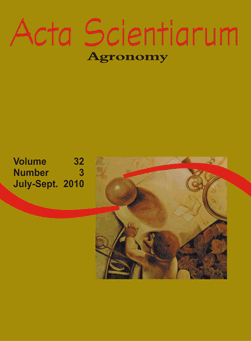<b>Use of microbial and chemical agents to control <em>Meloidogyne incognita</em> in soybean</b> - doi: 10.4025/actasciagron.v32i3.2166
Keywords:
Glycine max, Paecilomyces lilacinus, Pochonia chlamydosporia, Bacillus, Aldicarb, Root-knot nematodes
Abstract
Root-knot nematodes are considered significant pathogens of soybean crops. The objective of this work was to evaluate the efficacy of two fungi (Paecilomyces lilacinus (Thom.) Samsom and Pochonia chlamydosporia (Goddard) Zare & Gams (syn. Verticillium chlamydosporium), a commercial product based on Bacillus sp. and Aldicarb on the control of Meloidogyne incognita on soybean, cultivar M-SOY 6101. The experimental design was set as randomized blocks with four replications. Nine treatments were evaluated: three biological agents used for seed treatment with and without post-emergence application, Aldicarb on post-emergence only, and two controls. All treatments were inoculated with the nematode, except for a blank control where only water was applied. One control-only treated with the nematode was also included. Aldicarb could reduce the number of eggs and juveniles in the roots. P. lilacinus showed the best performance among the biological control agents, reducing the number of eggs and increasing dry root weight. Nemix, a Bacillus sp. based commercial product and P. chlamydosporia could only reduce significantly the number of eggs of the nematode. In this work, it was possible to conclude that the chemical and biological agents showed a moderate activity in the control of M. incognita in soybean.Downloads
Download data is not yet available.
Published
2010-08-25
How to Cite
Nunes, H. T., Monteiro, A. C., & Pomela, A. W. V. (2010). <b>Use of microbial and chemical agents to control <em>Meloidogyne incognita</em> in soybean</b> - doi: 10.4025/actasciagron.v32i3.2166. Acta Scientiarum. Agronomy, 32(3), 403-409. https://doi.org/10.4025/actasciagron.v32i3.2166
Issue
Section
Crop Protection
DECLARATION OF ORIGINALITY AND COPYRIGHTS
I Declare that current article is original and has not been submitted for publication, in part or in whole, to any other national or international journal.
The copyrights belong exclusively to the authors. Published content is licensed under Creative Commons Attribution 4.0 (CC BY 4.0) guidelines, which allows sharing (copy and distribution of the material in any medium or format) and adaptation (remix, transform, and build upon the material) for any purpose, even commercially, under the terms of attribution.
2.0
2019CiteScore
60th percentile
Powered by 

2.0
2019CiteScore
60th percentile
Powered by 



















































